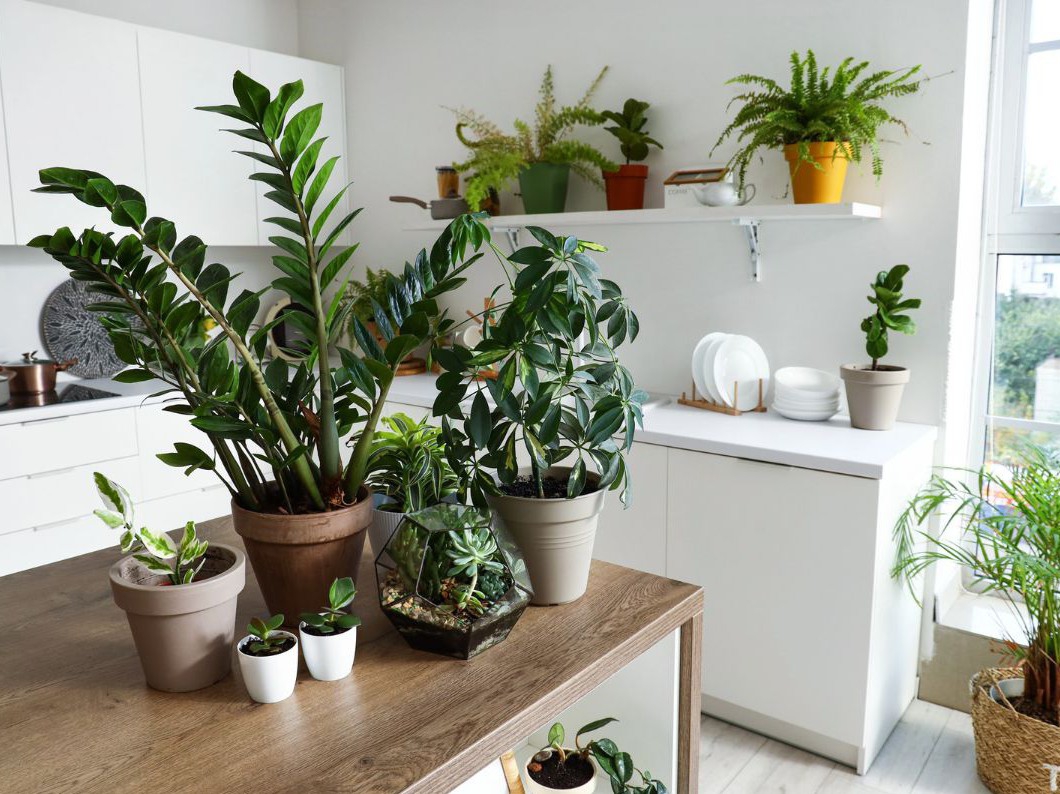
An indoor garden, whether it’s a collection of houseplants, flowers, vegetables, or herbs (or a mix of everything!), can not only bring a touch of colour and freshness to a home, but also create a soothing atmosphere.
Here are some tips to ensure your garden stays lush and green in both summer and winter.
The Right Place
Unsurprisingly, your indoor garden’s location is crucial to ensuring your plants thrive, especially in the low light of winter.
- Adequate light levels: Plants rely on light to photosynthesize. The best place for your garden is in front of a sunny window. South- or west-facing windows provide the most amount of light.
If your home doesn’t receive enough natural light, consider purchasing LED grow lamps or bulbs, which are specifically designed to mimic the sun’s rays.
You can also rotate your plants so they each have a turn in the sun. Or take them out onto your balcony!
- Stable temperature: Avoid positioning your plants near poorly insulated windows or close to drafts. Make sure the room’s temperature remains within a stable and comfortable minimum range of between 18 °C to 20 °C.
- Easy access: You want to set up your indoor garden in a convenient location for hassle-free maintenance, watering, and harvesting.
The Right Plants
Not all types of plants are suited to indoor gardening.
- The following species require little care and tolerate less than optimal light conditions.
Plants:
1. Ficus elastica (rubber plant)
2. Sansevieria (mother-in-law’s tongue)
3. Pothos
4. Anthurium
5. Aloe vera
6. Zamioculcas (ZZ plant)
7. Spathiphyllum (peace lily)
Flowers:
1. African violets: These delicate little flowers are perfect for the home. They grow best in indirect light and produce lovely violet or white blooms all year long.
2. Begonias: Begonias feature decorative leaves, and their flowers come in a wide range of hues. Again, they prefer shade or partial light.
3. Cyclamens: The cyclamen’s vibrant flowers will brighten any room on a winter’s day. They’re best suited to cooler temperatures.
- Culinary herbs: Basil, thyme, rosemary, mint, and chives grow well indoors but need regular watering.
- Vegetables: Lettuces, radishes, microgreens, spring onions, and dwarf tomatoes are your best bets for a bountiful harvest from an indoor container garden.
Good to know: These plants require deep pots and lots of sunlight.
The Other Essentials
In addition to plant selection, a few other factors will influence your indoor garden’s success. Don’t overlook the following:
- Appropriate containers: Always choose pots with drainage holes to prevent them from becoming waterlogged, which could lead to root rot. Plants can, moreover, quickly outgrow their container. Repot them every one to two years to help them flourish.
- Quality soil: Use a quality potting mix specially formulated to provide good drainage and optimal nutrition to indoor plants. Culinary herbs, for their part, grow best in a light, nutrient-rich soil.
- Watering system: Watering is key, but not too much. Be attentive to each plant’s particular needs (read the tag or look the information up online).
Air humidity may be low in winter, so don’t forget to mist your plants as necessary.
Proper Care and Maintenance
To keep your indoor garden in top condition throughout the year, it’s important to perform a few regular tasks.
- Watch out for pests: Houseplants are subject to aphid, mealy bug, or white fly infestations. Inspect your plants often and treat them as needed with a natural insecticide (like soapy water or essential oils).
- Clean the leaves: Dust can build up on the leaves’ surface and obstruct their pores. Gently wipe them down with a damp cloth or soft brush.
- Remove dead leaves: To avoid the spread of diseases and to keep your plants looking great, cut off withered or damaged leaves.
- Fertilize: Use a liquid or granulated fertilizer formulated for indoor plants to provide the nutrients they require during the growing season.
- Rotate the plants: Turn your plants frequently so that they receive an equal amount of light from all sides, and to prevent them leaning towards the light.
The Benefits
A garden of leafy plants and flowers will add a colourful, cheerful decorative touch to your home. The leaves and blooms’ vivid colours and varied textures will brighten and liven your interior. Furthermore, being surrounded by plants is relaxing and will improve your mood. Houseplants, such as the palm, ficus, or sansevieria can help purify the air by absorbing toxins and releasing oxygen. Lastly, there’s nothing more satisfying than preparing a meal with ingredients (vegetables and herbs) you’ve grown yourself.
Even if you’re no expert gardener, by following our tips you too can create a lush, productive indoor garden at home!

